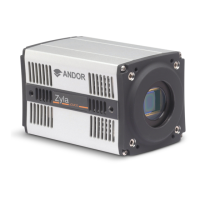version 2.0 rev 18 Feb 2021
43
2.6.3 Global Shutter Triggering Modes (Zyla 5.5 only)
Global Shutter triggering modes are available for Zyla 5.5 only. Global Shutter can also be thought of as
a ‘snapshot’ exposure mode, meaning that all pixels of the array are exposed simultaneously. Before the
exposure begins, all pixels in the array are cleared of charge using the Global Clear. At the start of the exposure
each pixel simultaneously begins to collect charge and is allowed to do so for the duration of the exposure
time. At the end of exposure, all pixels transfer their accumulated charge simultaneously to their read out node.
Global Shutter requires a reference frame to be read out of the sensor in addition to the signal frame, therefore
eectivelyhalvingtheframeratethatwouldhavebeenachievedinRollingShuttermode.
The Global Shutter signals shown in the diagrams are as follows:
• Acquisition Start: This is an internal pulse purely for illustrative purposes and indicates when the
camera receives a command from software to start the pre-programmed acquisition sequence.
• FIRE: In Global Shutter mode, the FIRE output indicates the exposure period, which is identical for all
pixels. This pulse is available to the user via the FIRE output pin.
NOTE: In Global Shutter Mode the behaviour of FIRE Row n, FIRE ALL and FIRE ANY are identical to
that of FIRE and therefore not shown in the diagrams.
• ARM: The ARM output from the camera is used for external and software triggering modes to indicate
when the camera is ready to accept another incoming trigger pulse.
• Global Clear: Global Shutter uses Global Clear to begin a new exposure. When this pulse is HIGH,
charge is drained from every pixel thus preventing the accumulation of charge on the sensor. When
the pulse is LOW, any photo-electrons generated are accumulating within the pixels, ready for transfer
to the sense node for subsequent readout. The falling edge indicates the start of an exposure.
• Charge Transfer: This signal indicates when charge in the pixel is transferred to the measurement
nodeandeectivelyendstheexposure.ThechargeistransferredwhilethepulseisHIGHandis
showninthediagramstoindicatethereisaspeciedtimebetweenreadingoutthereferenceand
signal frames.
• Frame Read Out Phase: This signal indicates when reference and signal frames are read out of the
sensor.
• InterFrame: Theinterframedenestheminimumtimetakenbetweenreferenceandsignalframe
readouts.
•
*
: Marks the start of an exposure.
•
*
: Marks the end of exposure.
The timing tables accompanying each of the triggering diagrams that follow indicate the exposure and cycle
times achievable in each triggering mode. These are based on Frame and Row Periods as shown below:
Table 22: Timing Parameters based on Sensor Clock Speed for Global Shutter
Parameter
Sensor Readout Rate
200 MHz 560 MHz
1 Row (2624 clock cycles) 25.41 µs 9.24 µs
1 Full Frame ( 2160 rows) 27.44 ms 9.98 ms
Charge Transfer Time 5.5 µs 2 µs
InterFrame (9 Rows) 228.7 µs 83.2 µs
1 Row is the time taken to perform 2624 clock cycles. The sensor is split into 2 halves with each having an
independent data output from the sensor. This means the Frame Period is 1080 rows x 2624 clock cycles.

